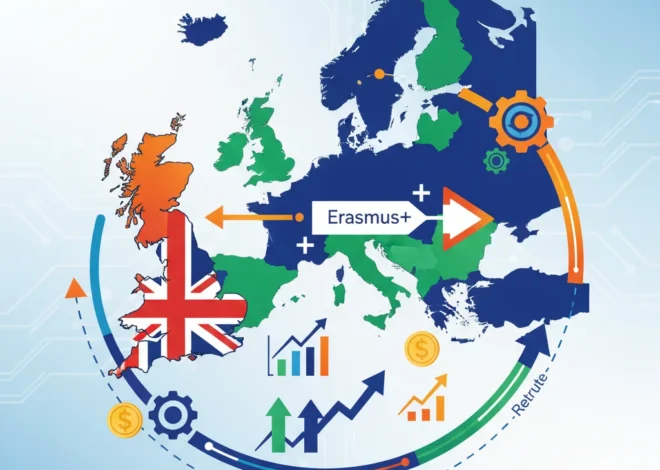
UK’s £420M Industrial Lifeline: A Strategic Investment or a Costly Stopgap?
In the high-stakes arena of global economics, the resilience of a nation’s industrial backbone is a critical measure of its strength. For the United Kingdom, industries like steel, chemicals, and manufacturing are not just economic assets; they are pillars of sovereign capability and major employers. However, these energy-intensive industries (EIIs) have been weathering a perfect storm of soaring energy costs, putting them at a severe competitive disadvantage. In a decisive move to shore up this vital sector, the UK government has announced a significant expansion of its support scheme, promising to cut energy bills for hundreds of businesses by a collective £420 million starting next year.
This policy adjustment is more than just a line item in the national budget; it’s a statement of intent about the future of British manufacturing. For investors, finance professionals, and business leaders, the announcement raises crucial questions. Is this a savvy move to protect key industries and attract investment, or is it a temporary patch on a much larger structural problem? As we delve into the mechanics of the policy, the industry’s reaction, and its broader economic implications, we’ll explore how this £420 million lifeline could reshape the landscape for the UK’s industrial giants and the stock market’s perception of them.
Decoding the EII Exemption Scheme: A Financial Shield for Industry
At the heart of the government’s announcement is the enhancement of the Energy Intensive Industries (EII) Exemption Scheme. But what exactly is this scheme, and how does it work? In essence, it’s a form of targeted financial relief designed to level the playing field for UK businesses that consume vast amounts of energy.
The UK, like many developed nations, has policies to support the transition to renewable energy. The costs of these policies, such as the Contracts for Difference (CfD) scheme, are typically passed on to all consumers through their energy bills. For a typical household, this might mean a few extra pounds per month. For a steel mill or a chemical plant, it translates into millions, creating a significant burden that competitors in countries with less aggressive green policies do not face.
The EII Exemption Scheme shields eligible businesses from a portion of these costs. The recent announcement significantly increases this shield. According to the official government guidance, the exemption from certain renewable energy levies will be raised from 85% to 100%, providing more comprehensive relief. This is a direct injection into the operational finances of these companies, aimed at preventing a phenomenon known as “carbon leakage.”
The Economics of Carbon Leakage
Carbon leakage is a critical concept in environmental economics. It occurs when stringent climate policies in one country lead businesses to relocate their production to jurisdictions with laxer regulations. The result is a double negative: the home country loses jobs and industrial capacity, and global emissions don’t actually decrease—they simply shift location. By reducing the policy-related cost burden, the UK government aims to make it more financially viable for these industries to remain—and invest—in Britain. This is a fundamental pillar of modern industrial strategy, where economic policy and climate policy must work in tandem.
Beyond the Hype: Where to Find Real Value in a World Obsessed with Private Credit
Industry Reaction: A Welcome Boost, But Is It Enough?
The response from the industry has been one of cautious optimism. While the additional support is undoubtedly welcome, many feel it doesn’t fully address the core issue of globally uncompetitive baseline energy prices. UK Steel, a prominent industry body, captured this sentiment perfectly, stating that while the support was appreciated, “the government could have gone further” (source).
To understand this perspective, it’s useful to compare the UK’s support mechanisms with those of its European rivals, particularly Germany, which also has a massive industrial base. While direct comparisons are complex due to differing energy markets and policy structures, the general sentiment among industry leaders is that continental competitors often receive more comprehensive state support.
Below is a simplified comparison illustrating the different approaches to industrial energy costs:
| Support Mechanism Feature | United Kingdom (Post-Announcement) | Germany (Example Policies) |
|---|---|---|
| Policy Cost Exemption | Increased to 100% exemption from certain renewable levy costs. | Significant reductions and caps on renewable energy surcharges (EEG-Umlage, now reformed). |
| Direct Price Caps/Subsidies | Generally targeted and scheme-based, not a broad price cap for industry. | Has implemented measures like the “Strompreisbremse” (electricity price brake) and is debating a long-term, subsidized industrial electricity price. |
| Network Charges Relief | Some relief available but often cited as a point of competitive disadvantage. | More extensive exemptions from electricity network charges for large, stable consumers. |
| Focus of Support | Primarily focused on shielding from the *costs of green policies*. | Broader approach, tackling policy costs, network fees, and at times, the underlying wholesale price. |
This table highlights why bodies like UK Steel might argue for more. The challenge isn’t just the “green premium” on bills but the entire cost structure. For investors analyzing the long-term viability of UK industrial assets, the government’s willingness to close this competitive gap with European peers is a key variable to watch on the stock market.
Looking ahead, the real transformation won’t come from exemptions alone. We should anticipate a “Phase Two” of this strategy, where continued support is explicitly linked to decarbonization milestones. This is where financial technology could play a fascinating role. Imagine a system where relief payments are administered via a fintech platform, with smart contracts on a blockchain transparently verifying a company’s progress against green targets. This could bring a new level of accountability and efficiency to industrial policy, turning a simple subsidy into a dynamic tool for change. This is the kind of forward-thinking approach that long-term investors should be looking for.
The Ripple Effect: Implications for Finance, Investing, and the Broader Economy
A policy of this magnitude doesn’t exist in a vacuum. Its effects will ripple across the UK’s financial and economic landscape, creating both opportunities and challenges.
For Investors and the Stock Market
For those involved in trading and investing, the immediate impact is clear. Companies in the steel, paper, glass, cement, and chemicals sectors will see a direct reduction in their operational expenditures (OpEx). This should, in theory, improve profit margins, increase free cash flow, and make their stock more attractive. The policy effectively de-risks investment in these sectors by mitigating one of their biggest vulnerabilities: energy price volatility. However, savvy investors will look deeper, assessing which companies are best positioned to use this financial breathing room to invest in long-term efficiency and decarbonization technologies.
For Banking and Corporate Finance
This government backing could also unlock further private capital. With a more stable and predictable cost base, these industrial firms become more “bankable.” It may become easier for them to secure favorable terms on loans from banking institutions for major capital projects, such as upgrading blast furnaces to electric arc furnaces. This public-private leverage is crucial for funding the multi-billion-pound transition to a green industrial base. The policy acts as a government signal to financial markets that these industries are considered strategically important and are being backstopped against existential threats.
Argentina's High-Stakes Gamble: Can Milei's Shock Therapy Secure a US Lifeline?
For the National Economy
On a macroeconomic level, the policy is a bet on supply chain resilience and domestic manufacturing. The COVID-19 pandemic and geopolitical instability have exposed the fragility of long, complex global supply chains. Maintaining a domestic capacity to produce foundational materials like steel and chemicals is increasingly seen not just as an economic goal, but a matter of national security. This £420 million investment can be framed as an insurance premium to protect that capacity, supporting thousands of high-skill jobs and contributing to the UK’s overall economic stability.
The Green Tightrope: Balancing Support with Sustainability
The ultimate challenge lies in ensuring this support accelerates, rather than hinders, the green transition. Critics of such subsidies argue they can be “brown” investments, artificially extending the life of carbon-intensive processes. The government and the industries themselves must counter this by demonstrating that the relief is enabling a shift to cleaner technologies. A recent report from the Climate Change Committee emphasized the need for industrial policy to be firmly aligned with Net Zero commitments.
This is where the future of industrial finance lies. The emergence of green bonds, sustainability-linked loans, and other innovative financial instruments provides a pathway. The companies that successfully pair this government operational support with green capital investment will be the long-term winners. The role of financial technology and fintech platforms in verifying green credentials and channeling investment will be paramount in ensuring this transition is both rapid and robust.
Conclusion: A Calculated Risk for a Competitive Future
The UK government’s decision to inject £420 million into its energy-intensive industries is a significant and complex move. It is a direct response to the clear and present danger posed by uncompetitive energy costs, aiming to safeguard jobs, preserve industrial capacity, and prevent carbon leakage. For the finance and investment community, it provides a welcome, if temporary, boost to the outlook for a critical sector of the stock market.
However, this policy is not a final destination. It is a bridge. Its success will be measured not by the industries it saves in 2025, but by the industries it helps create by 2035. The real test will be whether this financial shield gives companies the confidence and the capital to make the bold investments in innovation and decarbonization needed to thrive in a Net Zero world. The economics are clear: the future of British industry depends on walking this green tightrope successfully.


